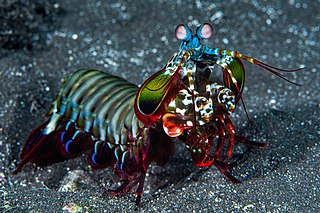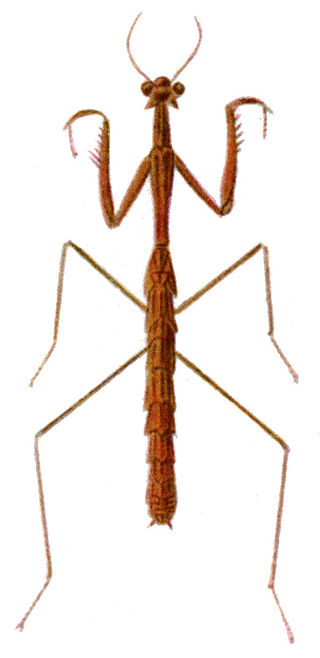
Mantis shrimp are carnivorous marine crustaceans of the order Stomatopoda. Stomatopods branched off from other members of the class Malacostraca around 340 million years ago. Mantis shrimp typically grow to around 10 cm (3.9 in) in length, while a few can reach up to 38 cm (15 in). A mantis shrimp's carapace covers only the rear part of the head and the first four segments of the thorax. Varieties range in colour from shades of brown to vivid colours, with more than 450 species of mantis shrimp known. They are among the most important predators in many shallow, tropical and subtropical marine habitats. However, despite being common, they are poorly understood, as many species spend most of their lives sheltering in burrows and holes.

The Carolina mantis is a species of praying mantis of the subfamily Stagmomantinae.

Northern Praying Mantis is a style of Chinese martial arts, sometimes called Shandong Praying Mantis after its province of origin. It was created by Wang Lang (王朗) and was named after the praying mantis, an insect, the aggressiveness of which inspired the style. One Mantis legend places the creation of the style during the Song dynasty when Wang Lang was supposedly one of 18 masters gathered by the Abbot Fu Ju (福居), a legendary persona of the historical Abbot Fu Yu, to improve Shaolin martial arts. However, most legends place Wang Lang in the late Ming dynasty.

The Chinese mantis is a species of mantis native to Asia and the nearby islands. In 1896, this species was accidentally introduced by a nursery tender at Mt. Airy near Philadelphia, United States. Tenodera sinensis often is erroneously referred to as Tenodera aridifolia sinensis because it was at first described as a subspecies of Tenodera aridifolia, but Tenodera sinensis is now established as a full species.

The European mantis is a large hemimetabolic insect in the family of the Mantidae ('mantids'), which is the largest family of the order Mantodea (mantises). Their common name praying mantis is derived from the distinctive posture of the first pair of legs that can be observed in animals in repose. It resembles a praying attitude. Both males and females have elongated bodies with two pairs of wings. The most striking features that all Mantodea share are a very mobile, triangular head with large compound eyes and their first pair of legs, which is highly modified for the efficient capture and restraint of fast-moving or flying prey.

Mantidae is one of the largest families in the order of praying mantises, based on the type species Mantis religiosa; however, most genera are tropical or subtropical. Historically, this was the only family in the order, and many references still use the term "mantid" to refer to any mantis. Technically, however, "mantid" refers only to members of the family Mantidae, and not the 14 remaining families of mantises. Some of the most recent classifications have promoted a number of the mantid subfamilies to the rank of family, e.g. Iridopterygidae, Sibyllidae, Tarachodidae, Thespidae, and Toxoderidae, while other classifications have reduced the number of subfamilies without elevating to higher rank.

Hymenopus coronatus is a mantis from the tropical forests of Southeast Asia. It is known by various common names including walking flower mantis and (pink) orchid mantis. It is one of several species known as flower mantises from their resemblance and behaviour. They are known to grab their prey with blinding speed.

Odontodactylus scyllarus, commonly known as the peacock mantis shrimp, harlequin mantis shrimp, painted mantis shrimp, clown mantis shrimp or rainbow mantis shrimp, is a large stomatopod native to the epipelagic seabed across the Indo-Pacific, ranging from Guam to East Africa, and as far South as Northern KwaZulu Natal in South Africa.

Flower mantises are praying mantis species that use a special form of camouflage referred to as aggressive mimicry, which they not only use to attract prey, but avoid predators as well. These insects have specific colorations and behaviors that mimic flowers in their surrounding habitats. This strategy has been observed in other mantises including the stick mantis and dead-leaf mantis. The observed behavior of these mantises includes positioning themselves on a plant and either inserting themselves within the irradiance or on the foliage of the plants until a prey insect comes within range. Many species of flower mantises are popular as pets. The flower mantises are non-nocturnal group with a single ancestry, but the majority of the known species belong to family Hymenopodidea.

Squilla mantis is a species of mantis shrimp found in shallow coastal areas of the Mediterranean Sea and the Eastern Atlantic Ocean: it is also known as "pacchero" or "canocchia". Its abundance has led to it being the only commercially fished mantis shrimp in the Mediterranean.

Ameles spallanzania, common name European dwarf mantis, is a species of praying mantis.

Stick mantis and twig mantis are common names applied to numerous species of mantis that mimic sticks or twigs as camouflage. Often the name serves to identify entire genera such as is the case with:
Oligonicella brunneri is one of the smallest species of praying mantis and "scarcely reach(es) one centimeter in length."
At 10 cm in length, Macromantis ovalifolia, in the subfamily Macromantinae, is one of the largest species of praying mantis.

Oratosquilla oratoria, the Japanese mantis shrimp, is a species of mantis shrimp found in the Western Pacific. It is widely harvested in Japan where it is known as shako and eaten as sushi. Like other members of its order it has a powerful spear, which it uses to hunt invertebrates and small fish. It grows to a length of 185 millimetres (7.3 in), and lives at depths of 10–100 metres (33–328 ft).

Lysiosquillina maculata, the zebra mantis shrimp, striped mantis shrimp or razor mantis, is a species of mantis shrimp found across the Indo-Pacific region from East Africa to the Galápagos and Hawaiian Islands. At a length up to 40 cm, L. maculata is the largest mantis shrimp in the world. L. maculata may be distinguished from its congener L. sulcata by the greater number of teeth on the last segment of its raptorial claw, and by the colouration of the uropodal endopod, the distal half of which is dark in L. maculata but not in L. sulcata. A small artisanal fishery exists for this species.

The Kanadi kingfish is a species of ray-finned bony fish in the family Scombridae, the mackerel family. Also known as the Kanadi seerfish, queen mackerel, or spotted mackerel, it is found in subtropical waters of the western Indian Ocean, Seychelles, Kenya and Zanzibar to South Africa and along the west coast of Madagascar. Kanadi kingfish commonly occur in depths of 50 to 200 m. Specimens have been recorded at up to 120 cm (47 in) in length, and weighing up to 12.5 kg (28 lb). They feed mainly on small fishes such as anchovies and clupeids, squids, and mantis shrimps.

The fauna of Italy comprises all the animal species inhabiting the territory of the Italian Republic and its surrounding waters. Italy has one the highest level of faunal biodiversity in Europe, with over 57,000 species recorded, representing more than a third of all European fauna. This is due to various factors. The Italian peninsula is in the center of the Mediterranean Sea, forming a corridor between central Europe and North Africa, and it has 8,000 km (5,000 mi) of coastline. Italy also receives species from the Balkans, Eurasia, and the Middle East. Italy's varied geological structure, including the Alps and the Apennines, Central Italian woodlands, and Southern Italian Garigue and Maquis shrubland, also contribute to high climate and habitat diversity.

Mantises are an order (Mantodea) of insects that contains over 2,400 species in about 460 genera in 33 families. The largest family is the Mantidae ("mantids"). Mantises are distributed worldwide in temperate and tropical habitats. They have triangular heads with bulging eyes supported on flexible necks. Their elongated bodies may or may not have wings, but all Mantodea have forelegs that are greatly enlarged and adapted for catching and gripping prey; their upright posture, while remaining stationary with forearms folded, has led to the common name praying mantis.















